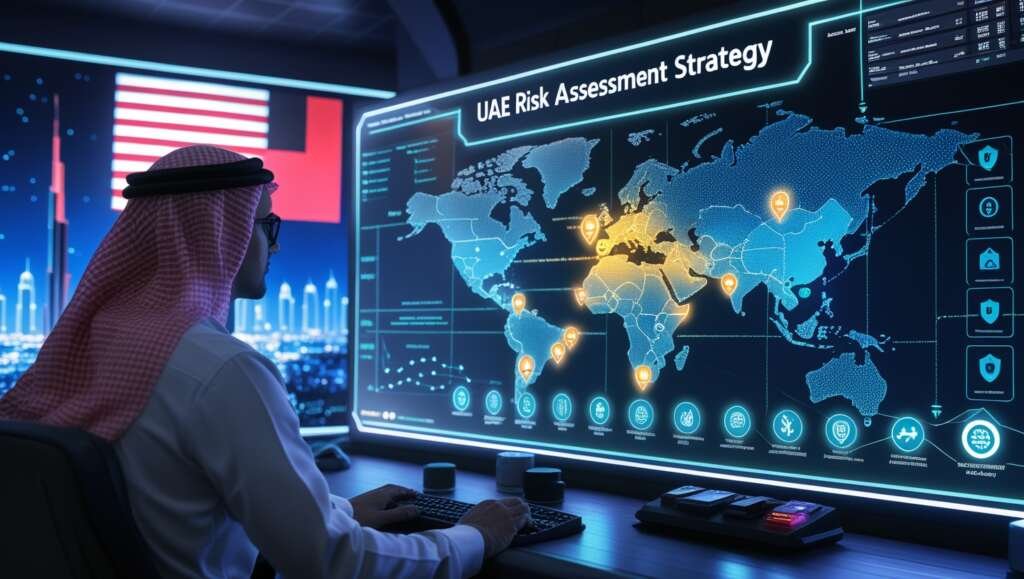In the heart of the UAE’s booming financial scene—where global banks and crypto pioneers share the skyline—a quiet revolution is taking shape. It’s not driven by tech or takeovers, but by something deeper: a smarter way to measure and manage risk.
The Central Bank of the UAE (CBUAE) and the Virtual Assets Regulatory Authority (VARA) are leading this charge, demanding that the biggest players in the financial world – the “Tier 1” banks and systemically important crypto firms (known as VASPs) – move beyond guesswork. They must now use precise numbers and clear “Key Risk Indicators” (KRIs) to understand exactly what dangers lurk, how close they are to trouble, and what to do when warning bells ring.
Imagine the financial system as a city’s power grid. The economy is the electricity flowing through it, powering homes and businesses. Financial institutions are the substations and transformers, distributing that power safely. The CBUAE acts like the control center, monitoring every circuit, enforcing safety limits, and ensuring there’s a backup plan in case of a surge or blackout. This way, the lights stay on — even during a storm.
The Power of “Quantifiable Risk”: Beyond Gut Feelings
For decades, risk management often involved a mix of experience, intuition, and some basic calculations. But today’s financial world is far too complex for that. Every second, millions of transactions fly across borders, new digital currencies emerge, and global events can send markets tumbling.
This is where “quantifiable risk” comes in. It’s about turning potential dangers into measurable data points. Instead of saying, “We might have a problem with bad loans,” financial firms now say, “Our non-performing loan ratio just hit 3.5%, which is entering our ‘amber’ warning zone.” This precision allows for immediate, targeted action.
What exactly are KRIs? They are like your car’s dashboard indicators: a speedometer, a fuel gauge, or an oil pressure warning light. For a financial firm, KRIs are specific, measurable metrics that reveal the health of different parts of their business and their exposure to various risks.
For example, a KRI might be:
- “How much capital do we have compared to the risks we’re taking?”
- “How quickly can we get cash if there’s a sudden rush of withdrawals?”
- “What percentage of our customers are failing to pay back their loans?”
- “How much money could we lose in our trading investments on a bad day?”
- “How often do our critical online banking systems go down?”
The CBUAE insists that these KRIs aren’t just for show. They must have clear “red line” or “warning” levels set by the bank’s top leadership. If a KRI crosses one of these lines, it’s not just a statistic; it’s a trigger for immediate action.
The CBUAE’s Core Demands: A Three-Pillar Approach
The UAE’s regulators have built a sophisticated framework that demands this numerical precision from their top financial institutions. It rests on three main pillars:
Pillar 1: The ICAAP (Internal Capital Adequacy Assessment Process)
Imagine a builder planning a skyscraper. Before a single brick is laid, they need to know if the foundation is strong enough for the building’s size and the winds it will face. That’s what ICAAP is for banks and large crypto firms.
The CBUAE makes it mandatory for these firms to conduct their own deep dives into all possible risks they face. This isn’t just about the obvious risks like loans going bad (Credit Risk) or investment prices dropping (Market Risk) or computer systems failing (Operational Risk). It also includes less obvious ones like:
- Interest Rate Risk: How changes in interest rates could affect their profits.
- Concentration Risk: Having too much money tied up with one customer, one industry, or one country.
- Reputational Risk: The damage from bad press or a scandal.
- Strategic Risk: The danger of making bad business decisions.
- Legal & Regulatory Risk: The cost of breaking laws or rules.
For each of these risks, the CBUAE demands specific ways to measure them with numbers. This helps the firm calculate exactly how much “safety money” (capital) they need to set aside. They must also use these numbers to:
- Forecast their financial health: See how they’ll look financially in the future, under normal and stressful conditions.
- “Stress Test” their plans: Imagine the worst-case scenarios (like a major economic downturn or a massive cyberattack) and see if they still have enough capital to survive.
Crucially, the CBUAE emphasizes that the firm’s “risk appetite” – how much risk they are willing to take – must be tied to these measurable KRIs. If a KRI shows they’re getting too close to their risk limit, it’s a clear signal to slow down or change course.
Pillar 2: Recovery and Resolution Planning
Even the strongest ships can hit stormy weather. Since December 2023, the CBUAE has required all major financial firms to have detailed “Recovery Plans.“ These aren’t just vague ideas; they’re specific, step-by-step guides on how the firm will save itself if it faces a severe crisis.
At the heart of these plans are “Quantitative Recovery Indicators.” These are key numbers that act as triggers. For instance:
- Capital Levels: If the bank’s core capital (CET1/Tier 1) drops below a certain point.
- Cash Levels: If their Liquidity Ratios (like LCR and NSFR) fall too low.
- Profitability: If their earnings (RoA, RoE) start to tank.
- Loan Health: If too many loans begin to fail (NPL% rises).
These “triggers” are not random. They are pre-set and approved by the firm’s Board, tested against extreme scenarios, and plugged into an “Early Warning Framework.” This means if a number hits a “red line,” an alarm sounds, and the firm knows exactly which recovery steps to take. The CBUAE has warned that ignoring these KRI signals or failing to set them up properly can lead to serious penalties.
Pillar 3: The Model Management Standard (MMS&G)
Modern finance relies heavily on complex computer programs, or “models,” to predict everything from customer behavior to market crashes. These models are crucial for calculating risks, setting prices, and managing money. But what if the model itself is wrong?
The CBUAE’s Model Management Standard (MMS&G), introduced in December 2022, tackles this head-on. It’s a game-changer because it treats the models themselves as a source of risk. Here’s how:
- A Full List of All Models: Every financial firm must keep a complete, detailed inventory of every single model they use – whether it’s for managing risk, calculating capital, pricing products, or forecasting liquidity.
- Rigorous Testing for Every Model: Just like a new car needs crash tests, every financial model needs rigorous quantitative testing. This includes:
- Performance Tracking: Continuously checking if the model is giving accurate results. For example, if it’s supposed to identify good vs. bad loan applicants, are its predictions actually correct? They use metrics like “AUC” (Area Under the Curve) to measure how well a model can tell the difference, and “RMSE” (Root Mean Squared Error) to see how far off its predictions are on average.
- Statistical Back-testing: This is like checking if a weather forecast was actually right. They compare the model’s past predictions with what actually happened. For example, if a model predicts that trading losses won’t exceed a certain amount 99% of the time, they’ll check if actual losses stayed within that limit. If there are too many “breaches” (actual losses exceeding the prediction), the model might need fixing.
- Sensitivity Analysis & Benchmarking: This involves seeing how the model’s results change if you tweak its assumptions slightly. They also compare the model’s performance against simpler methods or against what other firms are doing.
- Independent Watchdogs for Models: The CBUAE insists that firms must have a separate, independent team – a “Model Risk Management” (MRM) function – whose job it is to challenge and validate these models. This team reports directly to the highest levels of the firm, including the Board’s risk committees, ensuring no one can sweep model problems under the rug.
- Model Risk as a Standalone Threat: This is a big one. Firms now have to formally recognize and measure “Model Risk” as a separate type of danger. This means tracking:
- Model Breaches: When a model behaves unexpectedly or its assumptions are violated.
- Override Rates: How often human managers choose to ignore or change a model’s recommendation. Too many overrides can signal that the model isn’t trusted or isn’t working correctly.
- Validation Exceptions: Any unresolved issues found during the model testing process.
This deep dive into models ensures that the very tools used to measure risk are themselves reliable and transparent.
KRIs in Action: Gauges for Every Risk
The CBUAE expects banks and crypto firms to develop specific, measurable KRIs for every major type of risk they face:
- Capital Risk: How much “safety money” they have. KRIs include the CET1 Ratio (core capital strength) and Total Capital Ratio. They also track how close they are to hitting minimum capital levels and how much of their “safety buffer” they’re using up.
- Liquidity Risk: Their ability to pay immediate bills. KRIs include the Liquidity Coverage Ratio (LCR) for short-term cash needs and the Net Stable Funding Ratio (NSFR) for long-term stability. They also watch how much cash flows in versus out over different periods.
- Credit Risk: The danger of loans not being paid back. KRIs include the Non-Performing Loan (NPL) Ratio (percentage of bad loans) and how well those bad loans are covered by reserves. They also track how concentrated their loans are (e.g., too many loans to one sector) and how their borrowers’ credit ratings are changing.
- Market Risk: The risk from swings in investment prices. KRIs like Value at Risk (VaR) estimate potential daily losses. They also run “stress tests” to see what happens in extreme market conditions and watch their exposure to foreign currencies.
- Operational Risk: The risk of internal screw-ups, failures, or external events. KRIs include the number and cost of operational losses (like fraud or system errors), system uptime for crucial online services, and the number of cybersecurity incidents.
- Reputational & Compliance Risk: The risk of losing public trust or breaking rules. KRIs include the number of regulatory fines received, the volume of suspicious activity reports (SARs) filed (for potential money laundering), and even how often they are mentioned negatively in the media.
- Profitability & Earnings Risk: How well the firm is making money. KRIs look at Return on Assets (RoA), Net Interest Margin (NIM), and how volatile their earnings are quarter to quarter.
Special Focus: Keeping Crypto Safe
For VASPs (crypto firms), VARA’s rules add unique KRIs because of the specific risks in the virtual asset world:
- Custody & Wallet Risk: How securely customer crypto assets are held. KRIs track what percentage of assets are in highly secure “cold storage” (offline) versus “hot wallets” (online) and how quickly they can recover from a security breach.
- AML/CFT & Transaction Risk: Fighting financial crime in crypto. KRIs measure the percentage of transactions flagged by monitoring systems, how much exposure they have to high-risk countries, and the volume of transactions involving “unhosted wallets” or “mixers” (which can hide identities). They also track if they’re filing suspicious activity reports on time.
- Cybersecurity & Resilience (Crypto-Specific): How fast they detect and respond to cyberattacks on their unique crypto infrastructure. KRIs include Mean Time to Detect (MTTD) and Mean Time to Respond (MTTR) for cyber threats, and how well they pass “penetration tests” (simulated attacks).
Building a Stronger Financial Future
The CBUAE’s rigorous demands for risk quantification and KRIs are about building a financial system that is not only robust but also incredibly transparent and responsive. By forcing financial institutions to put hard numbers on every potential danger, regulators are ensuring that they can:
- Spot Weaknesses Early: Act before small problems become big crises.
- Make Smarter Decisions: Allocate resources wisely and pursue growth safely.
- Boost Confidence: Instill greater trust among customers and investors in the stability of the UAE’s financial sector.
In an ever-changing financial world, the UAE is betting on the power of numbers to keep its financial fortress secure, adapting quickly to new challenges, from traditional banking to the cutting edge of virtual assets. It’s a proactive approach designed to safeguard the nation’s financial future for everyone.




